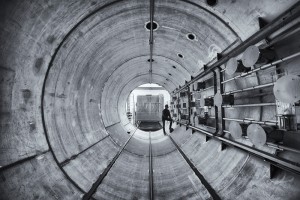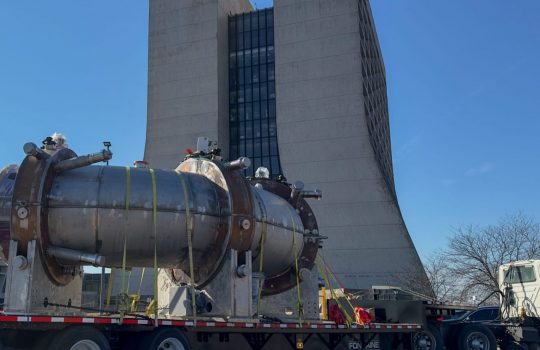
The Fermilab Short-Baseline Neutrino program will use three detectors: SBND, MicroBooNE (shown here) and ICARUS. Photo: Reidar Hahn
In 1995, physicists working on the Liquid Scintillator Neutrino Detector, or LSND, at Los Alamos National Laboratory stumbled upon some curious results.
The experiment, whose goal was to investigate oscillations between the three different flavors of the elusive neutrino, saw evidence that there might be at least one additional flavor of neutrino lurking just out of reach. In 2002, an experiment at Fermilab called MiniBooNE started collecting data to explore this anomaly, but the results were inconclusive: some data seemed to refute the possibility of a fourth neutrino, but other data seemed to indicate particle interactions that couldn’t be explained with conventional three-neutrino models. The possibility of a mysterious, fourth neutrino remained alive.
“It’s a question that’s been first lingering with the anomalies from LSND and then MiniBooNE,” said Bonnie Fleming, co-spokesperson of a new neutrino experiment at Fermilab called MicroBooNE. “There’s now a worldwide campaign to address whether these short-baseline oscillations and hints from other experiments are indicating new physics.”
Scientists from Fermilab and more than 45 institutions around the world have teamed up to design a program to catch this hypothetical neutrino in the act. The program, called the Short-Baseline Neutrino (SBN) program, makes use of a trio of detectors positioned along one of Fermilab’s neutrino beams. Although there are other reactor and source-based experiments in the world that actively seek a fourth neutrino, also called a sterile neutrino, SBN is the only program that uses a particle accelerator to produce neutrinos and multiple neutrino detectors for this search.
“No one else is doing an experiment like this,” said Peter Wilson, coordinator for the SBN program. “There are no other experiments on this energy scale using the concept of a near detector and a far detector.”
Determining whether there are more than three neutrino flavors would affect how scientists interpret data from experiments like the planned Deep Underground Neutrino Experiment, which is expected to make transformative discoveries about neutrinos, and perhaps other aspects of the universe, in the future. Solving the mystery of the anomalies seen at LSND and MiniBooNE, however, will not be easy. Because the sterile neutrino would not interact through the weak nuclear force as the other three do (hence the name “sterile”), detecting this particle would be like chasing the shadow of a ghost.
It begins at the Fermilab Booster, where protons are accelerated to 8 GeV and smashed into a target, creating new particles. Charged particles are bent forward by a magnetic focusing device into a tunnel where most decay to produce muon neutrinos. The three detectors — named the Short-Baseline Near Detector, or SBND, MicroBooNE and ICARUS — will be spread out over a distance of 600 meters. SBND, 100 meters from the target, will take data close to the source to reduce systematic uncertainties by measuring the initial characteristics of the muon neutrino beam. Four hundred meters beyond the planned site for SBND is MicroBooNE, which is already installed. ICARUS will be located 110 meters past MicroBooNE. ICARUS is an existing detector from a previous experiment at the Italian INFN laboratory at Gran Sasso that is currently being refurbished at CERN. It will have a massive chamber holding 760 tons of liquid argon to beat down statistical uncertainties in the experiment.
All three of the detectors are time projection chambers, a type of detector that allows physicists to analyze particle collisions in three dimensions. For these particular TPCs, scientists use liquid argon because its relatively heavy mass ensures a higher rate of interactions.
MicroBooNE received its last fill of liquid argon in July and recently began taking data. Scientists are expecting to break ground on buildings for both ICARUS and SBND by this fall. In 2017, ICARUS will be fully refurbished and delivered to Fermilab. Scientists hope to complete building SBND that same year.
Since experimenters won’t be able to directly detect the sterile neutrino, they will search for clues in the trails of particles the three known neutrino flavors leave behind in the liquid argon after they interact. If the experiments, expected to begin running in 2018, see deviations in the expected neutrino oscillation pattern, scientists will know that they’re on the right track in their hunt for this fugitive particle. If not, they will be able to put the mystery of the sterile neutrino to rest.
“If we design a strong enough experiment, which I believe we have, then one of two things will happen when we start taking data,” said David Schmitz, co-spokesperson for SBND. “Either we will rule out the earlier hints, or we make, frankly, the most exciting discovery in particle physics in some time.”



